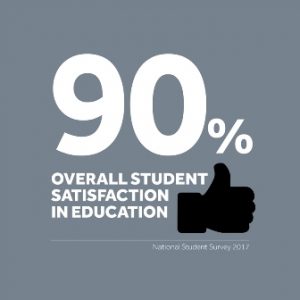
Students are at the heart of our Institute of Education (IoE). We aim to engage and challenge them, enabling them to reach their full potential to transform lives through education.
And so we’re delighted that our final year students have rated their educational experience so highly in the 2017 National Student Survey (NSS) published today (Wednesday 9th August), with a 90% satisfaction score for the IoE.
Students taking part in the survey are asked a series of questions about aspects of university life, including teaching, assessment and feedback, learning resources, and student voice.

We really value the results, as they help us to enhance the student experience at the IoE. They also help prospective students to make an informed choice about where they want to study.
The 2017 NSS was completed by more than 1,600 final year students at the University of Reading.
Overall satisfaction across the University remains strong, with our 2017 score matching the sector average at 84%.
Satisfaction also continues to perform well at departmental level, with eight departments, including the IoE, achieving a satisfaction score of 90% or above.
Professor Gavin Brooks, Pro-Vice-Chancellor for Teaching & Learning at the University of Reading, said:
“It is pleasing to see that a number of our departments have achieved a satisfaction rating of over 90%.
“We are extremely grateful to all final year students who took the time to complete the NSS, and we look forward to using their feedback to help make Reading even better.”
Several changes were made to the wording and structure of the Survey this year and, as a result, The UK Student Information Advisory Group and funding bodies have agreed that the 2017 data is not comparable to results from previous surveys and have advised that such comparisons should not be undertaken.
The NSS is an important measure of student satisfaction. It is carried out annually by Ipsos MORI; it contributes to other independent league tables; and it has built a broader picture of the quality of higher education since it started in 2005.
The statistics are publicly available at HEFCE.
